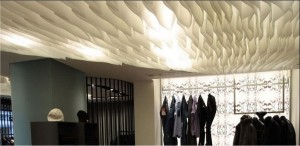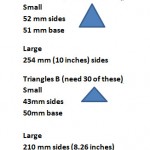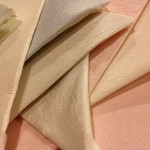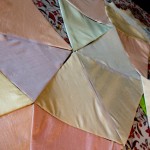This is structurally an interesting piece to me because of how they drape the cloth and use frames within the structure. It is also a really good example of the impact that lighting has on a piece. If you watch the process video you can see the construction and the way the piece looks inside and with out lighting.
http://www.situstudio.com/works/projects/reorder#
traditional feminine craft for traditional feminine worry
you’ll get tired of me
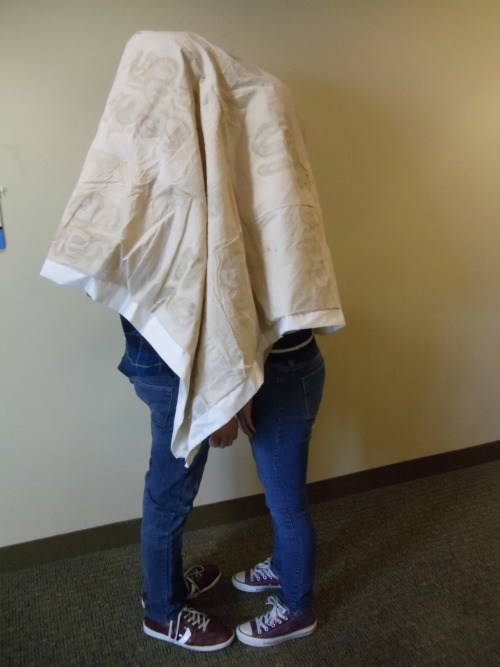
fabric squares batiked and dyed with coffee

 Once there was enough put together I pinned the corners of the out ring of points on the dome and tied string to secure it to the ceiling.
Once there was enough put together I pinned the corners of the out ring of points on the dome and tied string to secure it to the ceiling.
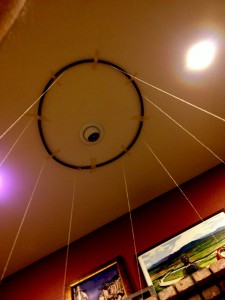
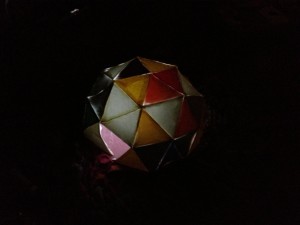
I also tried lighting it from inside to see what it would look like.


I had also wanted it to be lit by fire so I tried shooting pics of it near the fireplace.

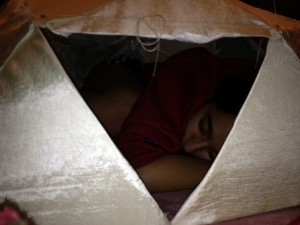
Here’s me inside it!
So my goals for this piece were to create a sort of geometric shell enclosure and to somehow incorporate the comfort in heat (hence the placement near the fireplace). I wanted it to be a strange extension to a practice I associate with companionship, cuddling by a fire. The shell is sort of a way of protecting and isolating its inhabitants. From the outside it also looks like a strange geometric creature sitting by the fire. The process proved to be extremely time consuming but I’m happy that it turned out dome/shell like.
I decided to create a wall of fabric, Initially, I wanted to have two walls of fabric hanging from the ceiling, much like a tunnel of fabrics. To me, big sheets of fabric hanging down from the ceiling recreates the atmosphere of a forest: being overwhelmed by the height and walking aimlessly through the trail. I thought it’ll be interesting to recreate that atmosphere in an urban setting.




Behind the scenes. I wanted to dye the fabric first. I’ve never dyed anything so I thought this assignment will serve as a good opportunity to experiment. I got Royal Blue and Sunshine Orange. I thought these colors would successfully convey the ambient atmosphere I was envisioning for the assignment. I kept listening to Ulrich Schnauss’ Celine while making this piece.

I created a prototype of a thread speaker to see if a conductive thread can act as a speaker. Surprisingly, the thread did play music, but it was very faint.
Also, I needed to see if I have to hand sew the thread speaker onto the fabric, or if I can use the sewing machine. I ended up hand sewing the speaker since I found it difficult to control the sewing machine. Because the speaker was in a spiral, I needed control over the needle.

After sewing the speaker onto the fabric, I connected the two ends of the speaker thread to a circuit to see if it actually worked. Unfortunately, I couldn’t get it to work last night, but I’m hoping it was the problem with how I connected the circuit board, rather than the problem of the actually thread speaker.

http://emilykatz.virb.com/embroideries
Really really beautiful embroidered illustrations.
Does work on several types of fabrics and also embroiders material like paper, which allows her to incorporate watercolors and other materials not as suited for fabric pieces.


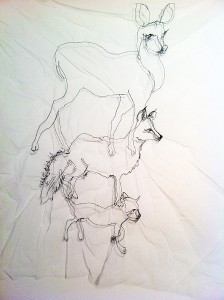

This artist has a really cool process for his embroidery works:
He “unworks” cross-stitch samplers, and then re-works the ground fabric in the same number of stitches and colors as the original composition (a ghostly outline remains).
http://www.briangrossfineart.com/exhibitions/ssollins05.html

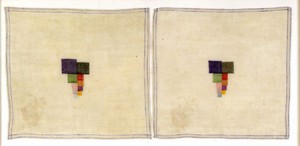
I really appreciate both the aesthetic and the process of his work.
A couple artists using fabric and sewing:

For some straight up lovely embroidery: Allison Watkins. Love the slight irony of embroidering images of fabric onto fabric, as well as just the aesthetics of this (thin, tenuous linework, etc.)
A slightly more process based artist using fabric: Ilysia Van Deren

She did a whole series of these handkerchiefs. Her statement is as follows:
How-To documents the process of ripping and re-sewing vintage handkerchiefs by hand, sometimes repeatedly. The projected video exposes a neurotic, obsessive process that is simultaneously mesmerizing and unsettling. The process acts as a means of releasing internalized experiences and frustrations, making the modification of each piece of fabric a uniquely personal and cathartic act. The hyper-detailed scanned images act as a document of the destruction; each fiber, tear and sloppy stitch on display for examination. Forever altered, these objects take on new identities. The act of repair becomes an integral part of a continuous cycle of destruction and reconstruction, of tearing down and building up.
Super into how process based this is, and the idea of destruction as construction (currently a Very Relevant Theme in my work)
There is also a video piece that goes with it:
How-To from Ilysia Van Deren on Vimeo.
Also a fan of this series by her:

This website is also a good reference
http://www.embroideryasart.com/
Here are some of Jenny Hart’s embroideries.

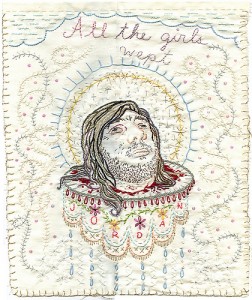
This piece is done in the 17th floor lobby of the Hilton Pattaya Hotel.

And this piece was done by Adrianopoulos and Associates.
